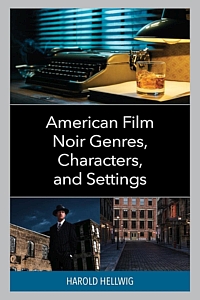Strongly influenced by domestic hard-boiled novels of the 1920s and 1930s, one of the most American film genres, film noir, had its boom time in the 1940s. Generally believed to have mostly vanished from studios and theaters by the late 1950s, the genre briefly resurfaces every few years in the so-called “neo noirs” of various directors from all over the world.

Author Harold Hellwig, professor of English in the Department of English and Philosophy at Idaho State University, strongly objects to this curtailed genre chronology. Instead, he argues that distinct aspects of the genre, its characters, settings, and a general uncertainty concerning relations and agendas of suspects and possible allies, did not simply cease to exist after the 1950s.
He sees many of those procedures still at work now, a bit concealed maybe, but alive and well. “Film noir, derived from and embedded within American cultures, found a new home in a variety of distinct and equal genres…” To prove this point, he lists a huge number of movies, as well as popular TV shows such as Have Gun – Will Travel, and the various CSI shows, among other productions, that still employ many of film noir’s major characteristics.
Furthermore, he sees evidence of its workings in several neighboring film genres, such as science fiction, the Western, detective shows and sometimes even comedy productions.
Step by step, readers here approach the succeeding themes after the classic introduction of the detective/investigator in the noirs and Los Angeles as one of the typical film noir locations (the other metropolis that comes to mind is New York City).
Roughly the first half of the book addresses typical settings, plots, quests, approaches of both femmes fatales, a corrupt police force and the standard hero (private investigator or victim of a conspiracy turned amateur sleuth) who tries to make sense of his situation, the (usually very dark) city, the complexity of his own isolation and often enough a deadline he has to meet.
Hellwig goes through various catalogs and lists, so to speak, and sets up concepts to identify film noir traits and reincarnations of these in present day cinema and TV shows. In most cases that makes perfect sense, but at times it is a bit intricate.
His chapter 6, “The Genre of Women as Controlling Figures” reintroduces both deadly women, redemptive angels, reliable partners and anything between the categorization of stereotypical female parts in classic films noir. And sets into motion thematic excursions to masterpieces such as Laura, Chinatown, Kiss Me Deadly, Double Indemnity, Vertigo, and others. However, Hellwig introduced his study with an even more complex challenge: “I will argue that the concept of what makes a film noir a film noir extends to the writing embedded in American culture from almost the beginning of the new American writing that Nathaniel Hawthorne represents.”
So especially in this chapter we find many links to Hawthorne’s The Blithedale Romance and Henry James’ Daisy Miller, two literary sources where Hellwig sees a strong likeness to future film noir plots and characters.
In the next part some particular aspects of films noir are under inspection, such as a brief excursion into science fiction with competent ideas about the two Blade Runner movies, Batman: The Dark Knight Returns and The Thirteenth Floor.
In chapter 8, the “Western as a Film Noir Genre” he relates to several films and TV shows (as well as present day detective shows), and apart from The Searchers basically centers on the character of Paladin (played by Richard Boone), star of Have Gun – Will Travel (1957-1963) and how or if he adjusted all or parts of his personality and code of conduct to the classic loner detectives of the city to his genre forefathers, in a way.
Hellwig’s analysis of how those features of original films noir keep emerging in contemporary American TV shows continues with emphasis on British shows (like Killing Eve or Luther). He also is convinced that a particular mindset or conceptualization of life and its problems as presented by noir protagonists can be traced back to a certain school of thought. He argues “… that a good deal of what film noir does is the work imposed by Immanuel Kant (and other philosophers) who suggests that one can create a reality by way of words and intellect.”
Finally, his combined and simultaneous approaches may not be appreciated by all readers, as several plots and movies he cites as being strongly in the vein of films noir, would not be accepted by all film experts or even movie buffs. It is even likely that some audiences may strongly disagree with his impressions presented in chapter 9, “Comedy as a Film Noir Genre” in particular, which deals with the TV comedy show Frazier (1993-2004).
Nevertheless, American Film Noir Genres, Characters, and Settings is an interesting read that, to some extent, covers so far untouched territories and productions. And as keeping an open mind to any useful connection between the classic film noir canon and present day developments – such as TV shows – is one main aspect of (academic) research, this title should be a welcome addition.
Review by Dr. A. Ebert © 2023
Harold Hellwig. American Film Noir Genres, Characters, and Settings. Lexington Books, 2023, 178 p.
